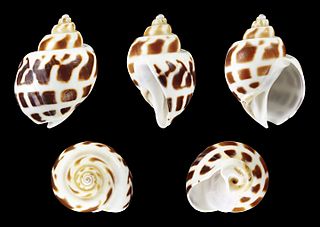Geodia gibberosa, commonly known as the white encrusting sponge, is a species of sea sponge found in the Caribbean. It is eaten by hawksbill turtles. It was first described by Lamarck in 1815.

Geodia is a genus of sea sponge belonging to the family Geodiidae. It is the type genus of its taxonomic family.

Babylonia areolata is a species of sea snail, a marine gastropod mollusc in the family Babyloniidae.
Felimare agassizii is a species of sea slug or dorid nudibranch, a marine gastropod mollusk in the family Chromodorididae.
Geodia acanthylastra is a sponge species from the family Geodiidae. The species is found in the waters of the Pacific Ocean off the coast of California and was first described by Robert Lendenfeld in 1910.
Geodia agassizi is a species of sponge in the family Geodiidae. The species is found in the eastern tropical Pacific Ocean and was first described by Robert Lendenfeld in 1910.
Geodia angulata is a species of sponge in the family Geodiidae. It is found in the Pacific Ocean off the coast of California.

Geodia megastrella is a species of sponge in the family Geodiidae. It is a type of demosponge found in the deep temperate waters of the North Atlantic Ocean. It has characteristic stellar-shaped large spicules coined 'megastrellum', hence its name. The species was first described by Henry John Carter in 1876, after dredging it up aboard H.M.S. 'Porcupine', near the Cape St. Vincent in Portugal.
Geodia macandrewii is a species of sponge in the family Geodiidae. It is found in the waters of the North Atlantic Ocean. The species was first described by James Scott Bowerbank in 1858.
Geodia atlantica is a species of sponge in the family Geodiidae. It is found in the waters of the North Atlantic Ocean.
Geodia bicolor is a species of sponge in the family Geodiidae. It is found in the waters of the Pacific Ocean off the coast of California.
Geodia breviana is a species of sponge in the family Geodiidae. It is found in the waters of the Pacific Ocean off the coast of California. It was first described by Robert J. Lendlmayer von Lendenfeld in 1910.
Geodia apiarium is a species of sea sponge in the family Geodiidae. It is found in the Gulf of Mexico off the coast of Florida.
Geodia arabica is a species of sponge in the family Geodiidae. It is found in the waters of the Arabian Sea and of the Red Sea. The species was first described by Henry John Carter in 1869.
Geodia conchilega is a species of sea sponge in the family Geodiidae.
Geodia nodastrella is a species of sponge in the family Geodiidae. It is found in the waters of the North Atlantic Ocean. The species was first described by Henry John Carter in 1876.
Geodia ataxastra is a species of sponge in the family Geodiidae. It is found in the waters of the Pacific Ocean near the coasts of Panama and Colombia. The species was first described by Robert J. Lendlmayer von Lendenfeld in 1910.
Geodia auroristella is a species of sponge in the family Geodiidae. It is found in the waters of the Indian Ocean around the Seychelles archipelago. The species was first described by Arthur Dendy in 1916.
Geodia erinacea is a species of sponge in the family Geodiidae. The species was first described by Lendenfeld in 1888. It is found in all the coastal waters of Australia.
Geodia gallica is a species of sponge in the family Geodiidae. The species was first described by Lendenfeld in 1907. It is found in the coastal waters of Agulhas Bank, next to South Africa.


